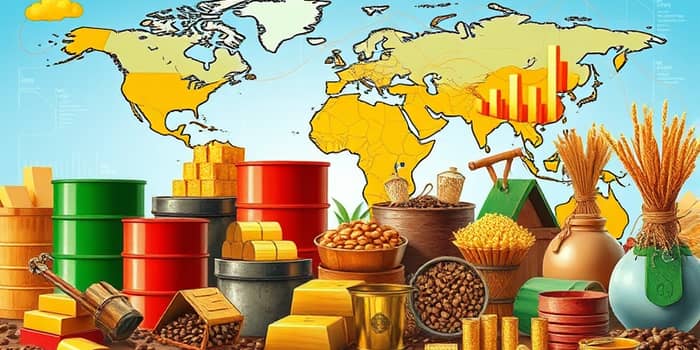
The raw materials market forms the bedrock of modern economic activity, influencing industries from energy production to agriculture. In 2025, traders and investors must navigate global economic slowdown and uncertainty to make informed decisions.
Commodities trading encompasses both physical exchange and complex derivatives. Understanding its mechanisms, recent data, and emerging trends can empower market participants to harness opportunities and mitigate risks.
At its core, commodities trading involves buying and selling primary goods such as oil, metals, and agricultural products. These assets underpin virtually all supply chains, making them critical to economic stability and growth.
The global commodities market is projected to reach a nominal value of US$142.85 trillion in 2025, driven predominantly by derivatives used for hedging and speculative activities. This massive scale reflects the essential role of raw materials in manufacturing, construction, and food production.
After a period of intense volatility during 2020–2024, commodity prices are forecast to fall by approximately 12% in 2025, with a further 5% decline expected in 2026. This trend is influenced by multiple factors, including supply improvements and policy uncertainties.
While energy markets lead the downturn, agricultural prices are poised to decline by about 1% in 2025 and 3% in 2026 as improved harvests meet subdued demand.
Prices in 2025 are shaped by interlocking economic, geopolitical, and financial factors that create unprecedented volatility over recent years:
Inflation moderation further diminishes commodities’ appeal as traditional hedges, while digital transformation and improved supply dynamics offer new dimensions to price discovery.
Effective participation in the raw materials market requires a blend of analytical skill and risk management. Derivatives such as futures, options, and forwards remain the primary tools for hedging price exposure. Investors also deploy physical holdings in exchange-traded funds or direct purchases for long-term diversification and hedging benefits.
Key tactics include:
Experienced traders, with deep expertise in supply-demand analytics and geopolitical dynamics, play a crucial role in providing liquidity and stabilizing prices through arbitrage and structured products.
The raw materials landscape is rapidly evolving under the influence of technological innovation and ESG imperatives. Participants must adapt to two transformative trends:
Carbon credits, renewable energy certificates, lithium, and cobalt have emerged as high-growth segments, driven by climate policies and decarbonization objectives. Meanwhile, blockchain and machine learning enhance transparency in supply chains and accelerate settlement processes.
In the energy sector, a supply surplus and slowing consumption growth keep crude oil prices subdued. Geopolitical events—especially in major producing regions—can still trigger sudden shocks.
Metal markets face headwinds from softening demand outside China, while precious metals may lose some safe-haven lustre as inflation eases. Agricultural commodities benefit from improved yields, though weather risks persist.
Projections for 2025 carry significant uncertainties. A sharper-than-expected downturn in major economies, escalations in trade conflicts, or a resurgence of inflation could swiftly reverse current forecasts.
Nevertheless, for those equipped with robust research, disciplined risk frameworks, and an eye on structural shifts, the raw materials market offers significant diversification and hedging advantages. By leveraging rapid technological advancements in trading, market participants can enhance decision-making and uncover new value streams.
As 2025 unfolds, the interplay between supply dynamics, policy decisions, and emerging green commodities will define opportunities and challenges. A deep understanding of these forces is essential for navigating the complex and ever-evolving world of commodities trading.
References













